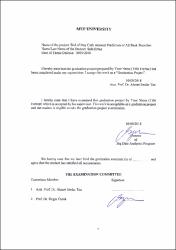Please use this identifier to cite or link to this item:
https://hdl.handle.net/20.500.11779/1174| Title: | End of Day Cash Amount Prediction of All Bank Branches | Authors: | Erbaş, Sefa | Advisors: | Tan, Ahmet Serdar | Keywords: | Daily Cash Flow Forecasting Cash Demand for Branches Cash Optimization Bank Branches Günlük Nakit Hareketleri Tahmin Etme Şubelerin Nakit İhtiyaçları Nakit Seviyesini İdeal Düzeyde Tutma Banka Şubeleri |
Publisher: | MEF Üniversitesi, Fen Bilimleri Enstitüsü | Source: | Erbaş, S.(2018). End of day cash amount prediction of all bank branches, MEF Üniversitesi Fen Bilimleri Enstitüsü, İstanbul, Türkiye | Abstract: | Today, although there are different payment methods available, most of the daily payments are made in cash¹. Accordingly, people's cash demand continues consistently. Due to its presence in most common networks, being as both supplier and custodian position of the cash money, the branches of the Bank are the most satisfying places that meet this need. In banks, the remaining cash at branches at the end of the day is idle money and leads to a potential loss of interest. The primary purpose of the banks is to leave cash at the branches at the optimum level and to obtain interest by depositing the excess cash to the Central Bank branches. The cash transfer is performed by outsourcing companies called CIT (Cash-inTransit). In this study, research was conducted to estimate branch end-of-day balances using different regression models. In order to reduce the effect of variance caused by the absence of any amount of limitation in transactions in branches, the daily estimation method has been adopted instead of the long-term estimation. The model has been developed for the estimation of the afternoon cash transaction amount of each branch based on before noon cash transaction details. The model output is grouped within a range of specific amounts, providing an output that determines the interval to take action for cash transfers. Günümüzde, her ne kadar farklı ödeme yöntemleri mevcut olsa da, günlük ödemelerin yarısından çoğu nakit ile yapılmaktadır. Buna bağlı olarak insanların nakit gereksinimi sürekli olarak devam etmektedir. Yaygın ağlarda bulunması, hem tedarikçi hem de saklayıcı konumunda olması sebebiyle, bu ihtiyacı en çok karşılayan yerler Banka şubeleridir. Bankalar açısından bakıldığında ise, gün sonunda şubelerde kalan nakit, atıl para konumundadır ve potansiyel faiz kaybına yol açmaktadır. Bankaların öncelikli amacı, şubelerde optimum düzeyde nakit bırakmak, fazla olan nakdi Merkez Bankası Şubeleri ’ne yatırarak faiz elde etmektir. Bu dengenin sağlanabilmesi için, para nakil hizmeti veren firmalar ile çalışılmaktadır. Bu çalışmada farklı regresyon modelleri kullanılarak, Şube gün sonu bakiyelerini tahmin etmeye yönelik araştırma yapılmıştır. Şubelerden gerçekleşen işlemlerde her hangi bir tutar sınırlaması olmamasının yaratacağı varyansın etkisini azaltabilmek amacıyla, uzun dönemli tahmin yapmak yerine, günlük tahminleme metodu benimsenmiştir. Her Şube özelinde, öğleye kadar yapılan işlemler baz alınarak öğleden sonra oluşabilecek nakit hareketlerinin tahmin edilmesi yönünde model geliştirilmiştir. Model çıktısı belirli tutarlar aralığında gruplanarak, hangi aralıkta nakit para nakli için aksiyon alınması yönünde çıktı sağlanmıştır. |
URI: | https://hdl.handle.net/20.500.11779/1174 |
| Appears in Collections: | FBE, Yüksek Lisans, Proje Koleksiyonu |
Files in This Item:
| File | Description | Size | Format | |
|---|---|---|---|---|
| SefaErbaş.pdf | original | 7.25 MB | Adobe PDF |  View/Open |
CORE Recommender
Page view(s)
14
checked on Jan 13, 2025
Download(s)
4
checked on Jan 13, 2025
Google ScholarTM
Check
Items in GCRIS Repository are protected by copyright, with all rights reserved, unless otherwise indicated.